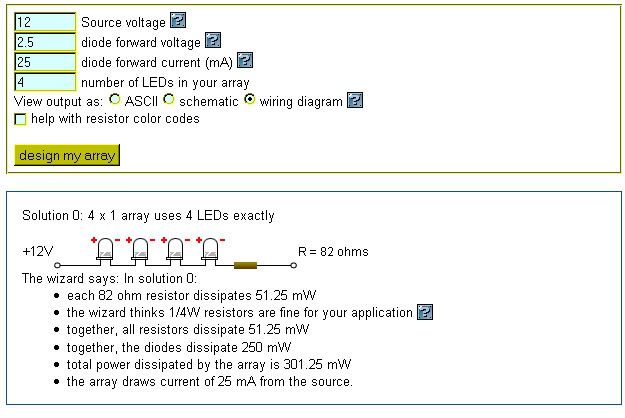the.fee.fairy wrote:1. Is there a limit to how many LEDs you can get running from one solar panel? If so, how do i calculate this?
This is dependent upon how big the panel is, and also, the capacity of the battery pack it's charging. I'd start from the other end - figure out how many LEDs you want, and how long you want them lit for. Then work out the battery size needed for this, and then see about a PV panel to charge the battery.
However you go about it, you will need a solar panel/battery pack, so lets look at how practical a DIY approach might be for assembling the LED part of the project. Here's an example I've been figuring out, with the aid of
this jolly useful LED circuit wizard.
Example: Using
these green LEDs (red won't show up well in green bottles, and it's easiest to keep all the LEDs identical within a circuit), and assuming we have a 12 volt power supply, we get this result from the wizard:

You can see that there are 4 LEDs daisy-chained together, along with a small 82 ohm resistor (it helps control the current). One end of the chain is connected to the +ve of the battery pack, the other end is connected to the -ve. You can add as many chains of four like this as you like (other numbers are possible, but let's keep things easy), each connected to the +ve and -ve of the battery. So if you needed 20 LEDs, you can make up 5 chains like these. I can't find an 82 ohm resistor on the Maplin site, but there is a 68 ohm version
of this which would prolly do the job.
As long as you use
decent wire, you can vary the distance between each LED to pretty much what you like, within reason, but try and keep the overall length of each chain about the same.
You can also see that each chain of 4 uses 25 milliamps, so 5 chains of 4 would use 125mA. Looking at a Ni-MH rechargeable battery, I see that an AA size is reckonned to be good for 1300 milliamp-hours at 1.2 volts, so 10 of these in series would add up to 12 volts and, in theory, provide about 10 hours of illumination. In practice, probably significantly less than this, as the voltage will drop as the batteries discharge. Maybe (guess) 5 hours of illumination. Bigger batteries than the AA size would last longer, or there may be better battery options, but solar chargers are readily available for AA batteries and the like.
Total cost of the LED chains for 20 LEDs:
20 green LEDs at 17p each = £3.40
5 resistors at 18p each = £0.90
Wire @ £3.69 for 25 meters
Plus a bit of solder, or maybe
connector blocks if you are not so handy with a soldering iron = £2.79
1 roll of
insulating tape to keep everything neat = £0.69
Total cost = about £12 plus the time to do it.
This, of course, is in addition to the power supply, which you will need whatever you do.
2. how do i waterproof it all?
You could put the battery(s) in a box or container, if it is to be outside. Drill holes for wires to go in and out, and seal these with silicone sealant. Could use this to seal the necks of the bottles after the LEDs are in them. At low voltages, PVC covered wires will prolly do without any further protection (the insulation may harden in sunlight), but if you bury them, make sure they are where you won't dig through them. Try and arrange things so that all your connections are enclosed inside the bottles.
3. Any idea how to stop the bottles getting dirty inside? I don't particularly want to have to take the bottles up every few months or so to clean them.
Reckon this may be covered by the above.
4. Do LEDs heat up a lot?
Most, hardly at all. Generally they use very little power, so there is very little heat output.
5. following on from that - are the bottles likely to break? if so, what's the best way to prevent it?
They are not likely to break as a result of putting an LED in them, but I can't comment about the effects of any other plans you may have for them.
Finally, if you play around with LEDs, remember that they only work one way round - if you connect the terminals the wrong way round, they won't light up, and may possibly be damaged (a diode is a bit like a one way valve for electricity - it only lets the current pass one way. A light emitting diode is one that happens to light up as it does it).
